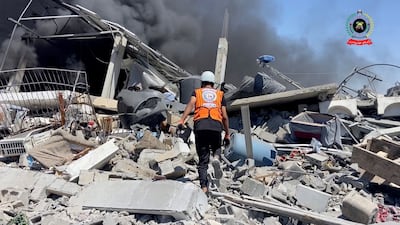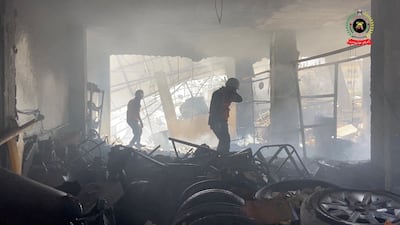One thing of which we can all be certain is that there will be consequences to what many legal experts are describing as a genocide in Gaza.
It is difficult to wrap one’s head around the excruciating pain being endured by Palestinians in the territory. We only know the rough outline of the devastation. Tens of thousands have been murdered in aerial bombardments, more than 100,000 have sustained serious injuries, the majority of homes have been demolished, and, as a result of Israel’s blockade, mass starvation is affecting more than one million people. In addition, schools and hospitals have been destroyed, and other essential services to provide support for births, illnesses, deaths and grieving, and treatment of the psychological wounds of war have been largely terminated.
We know that most of the dead and wounded are civilians, with the majority being women and children. We also know that upwards of 4,000 people have lost limbs. And many wounded children are the only survivors in their families, making them maimed orphans without a support network.
Much has been written before about the indecency of those “day after” discussions that focus exclusively on matters of governance or bricks and mortar while ignoring the human dimension and long-term consequences of this conflict. Of course, reconstruction issues are important, and it is gratifying that working papers are being developed to address them. But building housing and infrastructure and creating administrative structures should not be the sole considerations; attention must be paid also to addressing and healing the physical and psychological wounds of this war.
Consider the psychological wounds experienced by Gaza’s children. We know that significant losses produce trauma. Losing a parent, a sibling or a friend, or even just moving to a new neighbourhood can be unsettling and have an impact on behaviour or mental stability. We also know that the degree of the shock can be mitigated by other factors. For example, the discomfort experienced by a child when their family moves to a new city, and when they lose friends and a familiar environment, can be somewhat offset by a supportive family.
But what if, as is the case in Gaza, your family has lost many loved ones (parents, children and close extended family members), been forced to move several times, and is now living in a tent without food or water? And then imagine that during the last ceasefire, children, already traumatised by loss, joined the hundreds of thousands of Palestinians making the long trek northward to their old homes. What they find upon arrival is that not only their home but also their entire neighbourhood is rubble and unrecognisable. And then they are forced to deal with hunger and the indignity of witnessing their parents begging for food.
We know that as we grow, our brains organise our experiences so that they make sense to us. We develop a mental map of our relationships and our place in the world in which we live. But what if, in the case of a 12-year-old returning to Gaza city, they find that there is no home, and the way to school, the neighbourhood store, a friend’s home, or the mosque or school have all have been erased. The compounding of multiple losses and extreme dislocation can only be seen as profoundly traumatising. Under these circumstances, it is impossible to calculate the severity of the impact on this child’s well-being or future development. What will become of them, their older siblings and their parents? How will their brains ingest and make sense of all of these losses?
Given the seriousness of this situation, it becomes imperative not only to end the conflict and make plans for reconstruction and governance, but also to create strategies to address psychological and developmental needs. The US media focuses on the need to address the trauma of those young Israelis who have been held hostage in Gaza. This is obviously needed, but the extent to which the trauma experienced by Palestinians in Gaza has been ignored by so many, particularly in the US, is disturbing.
Why? In a word, racism. Many people, including many in America, apparently don’t see Palestinians as fully human, and so they fail to understand how destroying their lives, and denying them a normal present and a hopeful future, can result in deformities in their sense of self. If the rest of the world doesn’t demonstrate compassion and implement a comprehensive approach to rebuilding Gaza and restoring a sense of wholeness to its people, I fear what the future may have in store.
Even now, neither Israel nor the US has shown any interest in addressing the humanity of Palestinians. They are, instead, advancing plans that see this much-beleaguered people reduced to pawns to be moved about to help Israel achieve its goals.
The solution must come from a forceful and united stand taken by Arabs and key European states to sanction Israel for its crimes, force them to evacuate Gaza and end their occupation of Palestinian lands. Then and only then, under an international mandate, can reconstruction begin that will rebuild Gaza and help to heal the wounds of the Palestinian victims of this war.
If the international community does not take this course, the bitter seeds being planted today will be bearing fruit in future generations.
The specs
AT4 Ultimate, as tested
Engine: 6.2-litre V8
Power: 420hp
Torque: 623Nm
Transmission: 10-speed automatic
Price: From Dh330,800 (Elevation: Dh236,400; AT4: Dh286,800; Denali: Dh345,800)
On sale: Now
Dubai Bling season three
Cast: Loujain Adada, Zeina Khoury, Farhana Bodi, Ebraheem Al Samadi, Mona Kattan, and couples Safa & Fahad Siddiqui and DJ Bliss & Danya Mohammed
Rating: 1/5
Springsteen: Deliver Me from Nowhere
Director: Scott Cooper
Starring: Jeremy Allen White, Odessa Young, Jeremy Strong
Rating: 4/5
Specs
Engine: 51.5kW electric motor
Range: 400km
Power: 134bhp
Torque: 175Nm
Price: From Dh98,800
Available: Now
Lexus LX700h specs
Engine: 3.4-litre twin-turbo V6 plus supplementary electric motor
Power: 464hp at 5,200rpm
Torque: 790Nm from 2,000-3,600rpm
Transmission: 10-speed auto
Fuel consumption: 11.7L/100km
On sale: Now
Price: From Dh590,000
Mercer, the investment consulting arm of US services company Marsh & McLennan, expects its wealth division to at least double its assets under management (AUM) in the Middle East as wealth in the region continues to grow despite economic headwinds, a company official said.
Mercer Wealth, which globally has $160 billion in AUM, plans to boost its AUM in the region to $2-$3bn in the next 2-3 years from the present $1bn, said Yasir AbuShaban, a Dubai-based principal with Mercer Wealth.
“Within the next two to three years, we are looking at reaching $2 to $3 billion as a conservative estimate and we do see an opportunity to do so,” said Mr AbuShaban.
Mercer does not directly make investments, but allocates clients’ money they have discretion to, to professional asset managers. They also provide advice to clients.
“We have buying power. We can negotiate on their (client’s) behalf with asset managers to provide them lower fees than they otherwise would have to get on their own,” he added.
Mercer Wealth’s clients include sovereign wealth funds, family offices, and insurance companies among others.
From its office in Dubai, Mercer also looks after Africa, India and Turkey, where they also see opportunity for growth.
Wealth creation in Middle East and Africa (MEA) grew 8.5 per cent to $8.1 trillion last year from $7.5tn in 2015, higher than last year’s global average of 6 per cent and the second-highest growth in a region after Asia-Pacific which grew 9.9 per cent, according to consultancy Boston Consulting Group (BCG). In the region, where wealth grew just 1.9 per cent in 2015 compared with 2014, a pickup in oil prices has helped in wealth generation.
BCG is forecasting MEA wealth will rise to $12tn by 2021, growing at an annual average of 8 per cent.
Drivers of wealth generation in the region will be split evenly between new wealth creation and growth of performance of existing assets, according to BCG.
Another general trend in the region is clients’ looking for a comprehensive approach to investing, according to Mr AbuShaban.
“Institutional investors or some of the families are seeing a slowdown in the available capital they have to invest and in that sense they are looking at optimizing the way they manage their portfolios and making sure they are not investing haphazardly and different parts of their investment are working together,” said Mr AbuShaban.
Some clients also have a higher appetite for risk, given the low interest-rate environment that does not provide enough yield for some institutional investors. These clients are keen to invest in illiquid assets, such as private equity and infrastructure.
“What we have seen is a desire for higher returns in what has been a low-return environment specifically in various fixed income or bonds,” he said.
“In this environment, we have seen a de facto increase in the risk that clients are taking in things like illiquid investments, private equity investments, infrastructure and private debt, those kind of investments were higher illiquidity results in incrementally higher returns.”
The Abu Dhabi Investment Authority, one of the largest sovereign wealth funds, said in its 2016 report that has gradually increased its exposure in direct private equity and private credit transactions, mainly in Asian markets and especially in China and India. The authority’s private equity department focused on structured equities owing to “their defensive characteristics.”
More on animal trafficking
Paris%20Agreement
%3Cp%3EArticle%2014%3C%2Fp%3E%0A%3Cp%3E1.%20%5BThe%20Cop%5D%20shall%20periodically%20take%20stock%20of%20the%20implementation%20of%20this%20Agreement%20to%20assess%20the%20collective%20progress%20towards%20achieving%20the%20purpose%20of%20this%20Agreement%20and%20its%20long-term%20goals%20(referred%20to%20as%20the%20%22global%20stocktake%22)%3C%2Fp%3E%0A%3Cp%3E2.%20%5BThe%20Cop%5D%20shall%20undertake%20its%20first%20global%20stocktake%20in%202023%20and%20every%20five%20years%20thereafter%C2%A0%3C%2Fp%3E%0A
UAE currency: the story behind the money in your pockets
What is the definition of an SME?
SMEs in the UAE are defined by the number of employees, annual turnover and sector. For example, a “small company” in the services industry has six to 50 employees with a turnover of more than Dh2 million up to Dh20m, while in the manufacturing industry the requirements are 10 to 100 employees with a turnover of more than Dh3m up to Dh50m, according to Dubai SME, an agency of the Department of Economic Development.
A “medium-sized company” can either have staff of 51 to 200 employees or 101 to 250 employees, and a turnover less than or equal to Dh200m or Dh250m, again depending on whether the business is in the trading, manufacturing or services sectors.
UAE currency: the story behind the money in your pockets
Company profile
Company name: Nestrom
Started: 2017
Co-founders: Yousef Wadi, Kanaan Manasrah and Shadi Shalabi
Based: Jordan
Sector: Technology
Initial investment: Close to $100,000
Investors: Propeller, 500 Startups, Wamda Capital, Agrimatico, Techstars and some angel investors
KILLING OF QASSEM SULEIMANI
Results:
Men's 100m T34: 1. Walid Ktila (TUN) 15 sec; 2. Rheed McCracken (AUS) 15.40; 3. Mohammed Al Hammadi (UAE) 15.75. Men's 400m T34: 1. Walid Ktila (TUN) 50.56; 2. Mohammed Al Hammadi (UAE) 50.94; 3. Henry Manni (FIN) 52.24.
<html><head><meta http-equiv="Content-Type" content="text/html" charset="UTF-8" /></head><body><!--PSTYLE=* Labels%3aFH Label 18 Sport--><p>Beach soccer</p><!--PSTYLE=BY Byline--><p>Amith Passela</p><p /></body></html>
RESULT
Aston Villa 1
Samatta (41')
Manchester City 2
Aguero (20')
Rodri (30')
2.0
Director: S Shankar
Producer: Lyca Productions; presented by Dharma Films
Cast: Rajnikanth, Akshay Kumar, Amy Jackson, Sudhanshu Pandey
Rating: 3.5/5 stars








